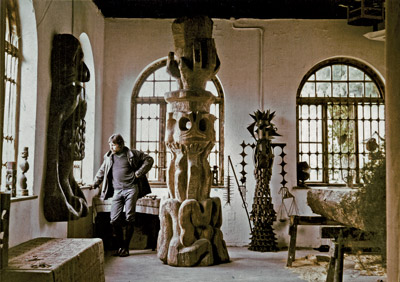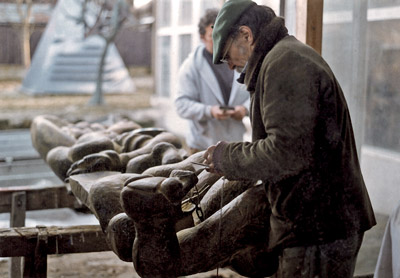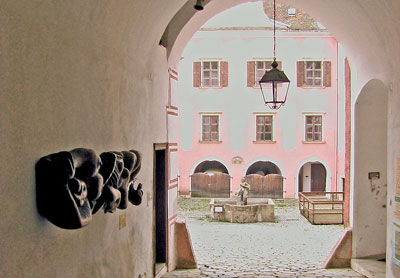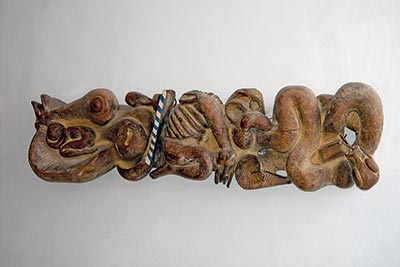 The artist created the wooden sculpture Life (1971–1972) at a time when he was giving intense consideration to the fate of man, his linkage with nature, and his task in history. He incorporated his philosophy into the work of art. In the photograph of his German studio from the start of the 1970s, we can see (from left to right) his sculptures Atom and People (1971–1972), Thaya – Fate of the Tree (1968), Iron Woman etc. – Justice and its Forms (1972) and a tree trunk intended for the sculpture Life.
The artist created the wooden sculpture Life (1971–1972) at a time when he was giving intense consideration to the fate of man, his linkage with nature, and his task in history. He incorporated his philosophy into the work of art. In the photograph of his German studio from the start of the 1970s, we can see (from left to right) his sculptures Atom and People (1971–1972), Thaya – Fate of the Tree (1968), Iron Woman etc. – Justice and its Forms (1972) and a tree trunk intended for the sculpture Life.



 The members of traditional pre-literary societies listened to nature and human naturalness. Modern technological, exponential progress has resulted in western culture and civilisation starting to ignore the knowledge that natural peoples had gained. Natural societies were governed by myths, religion and traditions considered primitive and unnecessary by modern society. The developed world must rediscover traditional values that restore the balance between the external and internal world. The preservation of abundance and diversity is important for a full life. This message is reflected in the wooden sculpture Life, which mirrors the beauty of biodiversity in the sense of the variety and the number of plant and animal species. People are responsible for the form of the world and the course of an individual life. But they are also forced to respect the principle of the inevitability and the fact that life is fated to an eternal cycle of birth and demise.
The members of traditional pre-literary societies listened to nature and human naturalness. Modern technological, exponential progress has resulted in western culture and civilisation starting to ignore the knowledge that natural peoples had gained. Natural societies were governed by myths, religion and traditions considered primitive and unnecessary by modern society. The developed world must rediscover traditional values that restore the balance between the external and internal world. The preservation of abundance and diversity is important for a full life. This message is reflected in the wooden sculpture Life, which mirrors the beauty of biodiversity in the sense of the variety and the number of plant and animal species. People are responsible for the form of the world and the course of an individual life. But they are also forced to respect the principle of the inevitability and the fact that life is fated to an eternal cycle of birth and demise.
Text: Barbora Půtová
Barbora Půtová (born 1985) is a Czech anthropologist and art historian lecturing at the Faculty of Arts, Charles University in Prague.
She deals with history of culture, artwork and cultural heritage. Other fields of her expert interest include historical anthropology, visual anthropology and anthropology of art.
She has published dozens of articles and experts studies as well as several expert monographs such as Pravěké umění (Prehistoric Art, co-authors Jean Clottes and Václav Soukup, 2011), Félicien Rops: enfant terrible dekadence (Félicien Rops: Enfant Terrible of Decadence, 2013), Kristkova podyjská glyptotéka (Kristek Thaya Glyptoheque, co-author Iveta K. Pavlovičová, 2013), The Genesis of Creativity and the Origin of the Human Mind (co-edited by Václav Soukup, 2015) or Královská cesta: všední i sváteční život v proměnách času (The Royal Route: Ordinary and Festive Life Over the Course of Time, 2016).
In her monograph Félicien Rops she offers the first comprehensive view of the life and work of one of the most prominent representatives of decadence and symbolism; in her last book Královská cesta (The Royal Route) she writes about the creation, development, meaning and historical changes of the Royal Route in Prague. In her book Skalní umění (Rock Art, 2015), she published the results of her field research of Palaeolithic art that she carried out at archaeological sites in France and Portugal.
At presents she is carrying out research of African rock art in the High Atlas Mountains of Morocco.
 The artist created the wooden sculpture Life (1971–1972) at a time when he was giving intense consideration to the fate of man, his linkage with nature, and his task in history. He incorporated his philosophy into the work of art. In the photograph of his German studio from the start of the 1970s, we can see (from left to right) his sculptures Atom and People (1971–1972), Thaya – Fate of the Tree (1968), Iron Woman etc. – Justice and its Forms (1972) and a tree trunk intended for the sculpture Life.
The artist created the wooden sculpture Life (1971–1972) at a time when he was giving intense consideration to the fate of man, his linkage with nature, and his task in history. He incorporated his philosophy into the work of art. In the photograph of his German studio from the start of the 1970s, we can see (from left to right) his sculptures Atom and People (1971–1972), Thaya – Fate of the Tree (1968), Iron Woman etc. – Justice and its Forms (1972) and a tree trunk intended for the sculpture Life. The members of traditional pre-literary societies listened to nature and human naturalness. Modern technological, exponential progress has resulted in western culture and civilisation starting to ignore the knowledge that natural peoples had gained. Natural societies were governed by myths, religion and traditions considered primitive and unnecessary by modern society. The developed world must rediscover traditional values that restore the balance between the external and internal world. The preservation of abundance and diversity is important for a full life. This message is reflected in the wooden sculpture Life, which mirrors the beauty of biodiversity in the sense of the variety and the number of plant and animal species. People are responsible for the form of the world and the course of an individual life. But they are also forced to respect the principle of the inevitability and the fact that life is fated to an eternal cycle of birth and demise.
The members of traditional pre-literary societies listened to nature and human naturalness. Modern technological, exponential progress has resulted in western culture and civilisation starting to ignore the knowledge that natural peoples had gained. Natural societies were governed by myths, religion and traditions considered primitive and unnecessary by modern society. The developed world must rediscover traditional values that restore the balance between the external and internal world. The preservation of abundance and diversity is important for a full life. This message is reflected in the wooden sculpture Life, which mirrors the beauty of biodiversity in the sense of the variety and the number of plant and animal species. People are responsible for the form of the world and the course of an individual life. But they are also forced to respect the principle of the inevitability and the fact that life is fated to an eternal cycle of birth and demise.





